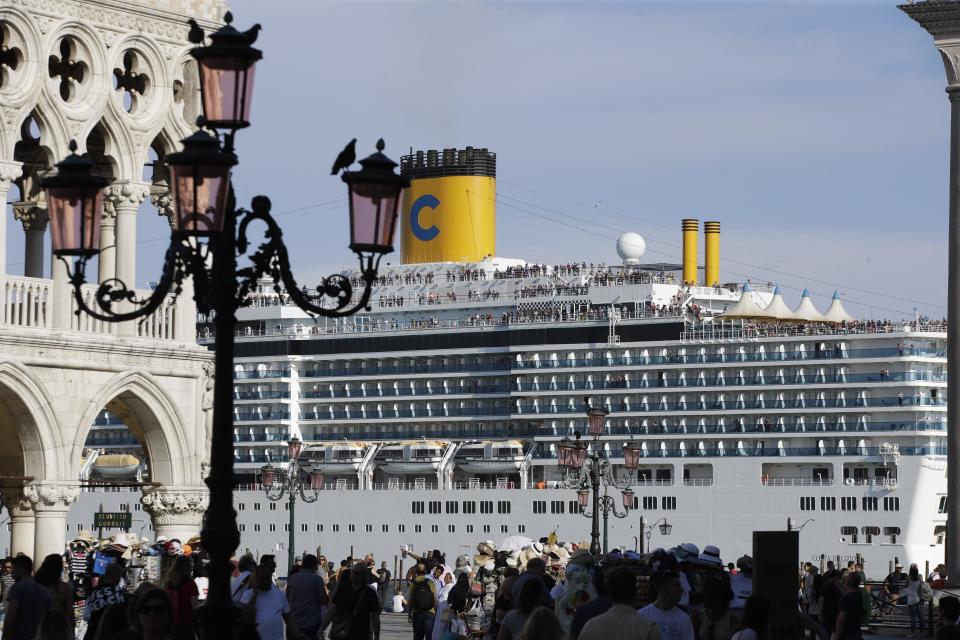Big cruise ships banned from entering central Venice

Rome — The Italian government has banned large cruise ships from passing through the center of Venice, declaring the surrounding lagoon a national monument after years of international outcry over the liners causing permanent harm to the fragile city.
"It is not going too far to define this day as historic," said Culture Minister Dario Franceschini, adding that the decree would go into effect on August 1.

"Ships will no longer pass in front of St. Mark's or the Giudecca Canal," he said, referring to the route they traditionally take through the center of the city.
Can Venice handle the COVID tourism rebound?
The law applies to ships weighing more than 25,000 tons, measuring more than 590 feet long, or more than 115 feet high.
Cruise ships, which returned in recent weeks after pandemic restrictions had kept them out for more than a year, are well known to destabilize Venice's delicate foundation.
Dwarfing the surrounding buildings, they can shake the underwater wooden piles that have reinforced the lagoon city for centuries. Meanwhile, their immense wake splashes onto the sides of medieval banks and Gothic palazzos, causing ancient bricks, stone, and stucco to crumble.
But Italy's government has waffled for years over reigning in the cruise ships, as they generate billions of euros in revenue for an economy that thrives on tourism, as well as employs thousands in the local cruise industry.
The decree issued on Tuesday seeks to safeguard those workers, offering to pay them lay-off benefits as well as compensating the cruise industry for having to cancel trips. The government's decision came just days before UNESCO, the United Nations heritage body, was poised to examine putting Venice on its endangered list at its plenary session on July 16 to 31.
In recent days, activists from the local "No Big Ships" group rallied on small boats and on the waterfront during the Group of 20 summit in Venice.
Many locals had been incensed by the lack of action since the Italian government announced in April that it was planning to ban cruise ships. With no other passenger port available for the ships to dock to let tourists disembark near Venice, the hulking ships were allowed to start cruising by Saint Mark's Square again this summer.
The new decree puts a stop to that, but far from banning cruise ships outright, they are just being redirected to the nearby industrial port of Marghera. That port is part of the same lagoon and ecosystem as Venice, raising serious questions about the efficacy of the new legislation.
"Moving large cruise ships to the industrial shipping canal is a huge problem in terms of erosion and pollution," Jane Da Mosto, an environmental scientist based in Venice, told CBS News. "The route is now even longer. That means burning more fuel. Moving the ships to Marghera we get the worst of both worlds."
The Marghera port channel will also require some serious modification to make it deep and wide enough to handle most cruise ships. For now, Da Mosto said the decree does, at least, eliminate the possibility of cruise ships crashing into Venice's historic center, like the 13-deck MSC Opera did in 2019 when it rammed into a dock as tourists below ran for their lives. Several people were injured.
More than 20 million tourists visit Venice annually, many aboard the 400 cruise ships that pass through the city in an average year. That deluge was reduced to a trickle during the pandemic, with only 20 liners scheduled to arrive by the end of 2021. But tourists are already flooding back into the ancient city as COVID-19 restrictions have eased, and direct flights from the U.S. to Venice are back on.
Major fires burning in 10 Western states with little chance of rain or cooler temperatures
Examining the economic impact of U.S.-Mexico border restrictions
Delta variant fuels a 50% jump in coronavirus cases in more than half of the U.S.

